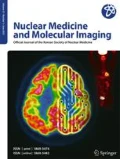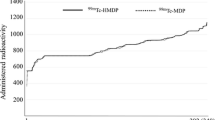Abstract
Purpose
There is substantial need for optimizing radiation protection in nuclear medicine imaging studies. However, the diagnostic reference levels (DRLs) have not yet been established for nuclear medicine imaging studies in Korea.
Materials and Methods
The data of administered activity in 32 nuclear medicine imaging studies were collected from the Korean Society of Nuclear Medicine (KSNM) dose survey database from 2013 and 2014. Through the expert discussions and statistical analyses, the 75th quartile value (Q3) was suggested as the preliminary DRL values. Preliminary DRLs were subjected to approval process by the KSNM Board of Directors and KSNM Council, followed by clinical applications and performance rating by domestic institutes.
Results
DRLs were determined through 32 nuclear medicine imaging studies. The Q3 value was considered as appropriate selection as it was generally consistent with the most commonly administered activity. In the present study, the final version of initial DRL values for nuclear medicine imaging in Korean adults is described including various protocols of the brain and myocardial perfusion imaging.
Conclusion
The first DRLs for nuclear medicine imaging in Korean adults were confirmed. The DRLs will enable optimized radiation protection in the field of nuclear medicine imaging in Korea.
Similar content being viewed by others
References
ICRP. Radiological protection and safety in medicine. ICRP Publication 73. Ann ICRP 26 (2).
Cho SG, Kim J, Song HC. Radiation safety in nuclear medicine procedures. Nucl Med Mol Imaging. 2017;51:11–6.3.
European Commission. Radiation protection 109: guidance on diagnostic reference level in medical exposures. 1999. https://ec.europa.eu/energy/sites/ener/files/documents/109_en.pdf. Accessed 19 Oct 2018.
European Commission. Radiation protection 180: diagnostic reference levels in thirty-six European countries. 2014. https://ec.europa.eu/energy/sites/ener/files/documents/RP180%20part2.pdf. Accessed 19 Oct 2018.
ICRP. Diagnostic reference levels in medical imaging: review and additional advice. Ann ICRP. 2001;31:33–52.
ICRP. Radiological protection in medicine. ICRP Publication 105. Ann. ICRP 37 (6).
ICRP. Diagnostic reference level in medical imaging. ICRP Publication 135. Ann ICRP 46(1).
Hart D, Wall BF. UK nuclear medicine survey 2003-2004. Nucl Med Commun. 2005;26:937–46.
Gray L, Torreggiani W, O’Reilly G. Paediatric diagnostic reference levels in nuclear medicine imaging in Ireland. Br J Radiol. 2008;81:918–9.
Roch P, Aubert B. French diagnostic reference levels in diagnostic radiology, computed tomography and nuclear medicine: 2004-2008 review. Radiat Prot Dosim. 2013;154:52–75.
Australian Radiation Protection and Nuclear Safety Agency (ARPANSA). National diagnostic reference level fact sheet. 2011. http://emrc.gov.jo/images/pdffiles/drl.pdf. Accessed 19 Oct 2018.
Japan Network for Research and Information on Medical Exposures (J-RIME). Diagnostic reference levels based on latest surveys in Japan - Japan DRLs 2015. http://www.radher.jp/J-RIME/report/DRLhoukokusyoEng.pdf. Accessed 19 Oct 2018.
Willegaignon J, Braga LF, Sapienza MT, Coura-Filho GB, Cardona MA, Alves CE, et al. Diagnostic reference level: an important tool for reducing radiation doses in adult and pediatric nuclear medicine procedures in Brazil. Nucl Med Commun. 2016;37:525–33.
Brink JA, Boone JM, Feinstein KA, Michalski JM, Pizzutiello Jr. RJ, Spelic DC et al. NCRP Report No. 172 - Reference levels and achievable doses in medical and dental imaging: recommendations for the United States. https://ncrponline.org/shop/reports/report-no-172-reference-levels-and-achievable-doses-in-medical-and-dental-imaging-recommendations-for-the-united-states-2012. Accessed 3 Jan 2019.
Hayton A, Wallace A, Marks P, Edmonds K, Tingey D, Johnston P. Australian diagnostic reference levels for multi detector computed tomography. Australas Phys Eng Sci Med. 2013;36:19–26.
Etard C, Celier D, Roch P, Aubert B. National survey of patient doses from whole-body FDG PET-CT examinations in France in 2011. Radiat Prot Dosim. 2012;152:334–8.
Vogiatzi S, Kipouros P, Chobis M. Establishment of dose reference levels for nuclear medicine in Greece. Radiat Prot Dosim. 2011;147:237–9.
Wallace AB. The implementation of diagnostic reference levels to Australian radiology practice. J Med Imag Radiat On. 2010;54:465–71.
EANM Pediatric and Dosimetry Committees. EANM Paediatric Dosage Card (Version 57.2016). 2016. https://www.eanm.org/content-eanm/uploads/2017/01/EANM_Dosage_Card_040214.pdf. Accessed 19 Oct 2018.
SNMMI. Pediatric Injected Activity Tool (Version 1.04; 13-Nov-2016). 2016. http://www.snmmi.org/ClinicalPractice/PediatricTool.aspx. Accessed 19 Oct 2018.
Treves ST, Gelfand MJ, Fahey FH, Parisi MT. 2016 update of the north American consensus guidelines for pediatric administered radiopharmaceutical activities. J Nucl Med. 2016;57:15N–8N.
Yoo I, Choi EK, Chung YA. The current status of SPECT or SPECT/CT in South Korea. Nucl Med Mol Imaging. 2017;51:101–5.
Kosuda S, Alam F, Yao Z, Kardinah K, Lee BN, Enkhthuya B et al. Report on the current nuclear medicine status of the Asian member states from the initial cooperative project meeting (RAS6061/9001/01) of International Atomic Energy Agency/Regional Cooperative Agreement (IAEA/RCA). Austral Asian J Cancer 2013;12:133–143.
National Institute of Food and Drug Safety Evaluation. Guidelines on patient dose for computed tomography. Administration of Radiation Safety Series No. 19. 2009. http://www.nifds.go.kr/brd/m_15/view.do?seq=2865&srchFr=&srchTo=&srchWord=&srchTp=&itm_seq_1=0&itm_seq_2=0&multi_itm_seq=0&company_cd=&company_nm=&page=83. Accessed 19 Oct 2018.
Kim MC, Han DK, Nam YC, Kim YM, Yoon J. Patient dose for computed tomography examination: dose reference levels and effective doses based on a national survey of 2013 in Korea. Radiat Prot Dosim. 2015;164:383–91.
Acknowledgments
We would like to thank the Korean Society of Nuclear Medicine Diagnostic Reference Level Task Force members including Drs. Min-Woo Kim (Presbyterian Medical Center), Byung Il Kim (Korean Institute of Radiological and Medical Sciences), Seong-Min Kim (Chungnam National University Hospital), Hyun-Yeol Nam (Samsung Changwon Hospital), Jin-Sook Ryu (Asan Medical Center), Ju Won Seok (Chung-Ang University Hospital), Byeong-Cheol Ahn (Kyungpook National University Hospital), Sun Young Oh (National Police Hospital), Young Hoon Ryu (Gangnam Severance Hospital), Ie Ryung Yoo (Seoul St. Mary’s Hospital), Yukyung Lee (National Medical center), Seok Tae Lim (Chonbuk National University Hospital), Ihnho Cho (Yeungnam University Hospital), Yun Young Choi (Hanyang University Medical Center), Joon Young Choi (Samsung Medical Center), Seung Jin Choi (Radiation Health Research Institute), Tae-Sung Kim (National Cancer Center), Eun Jeong Lee (Seoul Medical Center), Young Jin Jeong (Dong-A University Hospital), Young-Jun Heo (Suncheon St. Carollo Hospital), and the Nuclear Safety and Security Commission (NSSC) for a valuable contribution to establishing the first diagnostic reference level for nuclear medicine imaging in Korea.
Funding
This study was funded by the Nuclear Safety Research Program through the Korea Radiation Safety Foundation (KORSAFe) and the Nuclear Safety and Security Commission (NSSC), Republic of Korea (Grant No. 1305033).
Author information
Authors and Affiliations
Consortia
Corresponding author
Ethics declarations
Conflict of Interest
Ho-Chun Song has received research grants from the Nuclear Safety Research Program through the Korea Radiation Safety Foundation (KORSAFe) and the Nuclear Safety and Security Commission (NSSC), Republic of Korea (Grant No. 1305033).
Myung Hwan Na, Jahae Kim, Sang-Geon Cho, Jin Kyung Park, Keon-Wook Kang, and the other members of the Korean Society of Nuclear Medicine Diagnostic Reference Level Task Force declare that they have no conflict of interest.
Ethical Approval
This article does not contain any studies with human participants performed by any of the authors.
Informed Consent
The requirement to obtain informed consent was waived in this non-human-subject study.
Additional information
Publisher’s Note
Springer Nature remains neutral with regard to jurisdictional claims in published maps and institutional affiliations.
Rights and permissions
About this article
Cite this article
Song, HC., Na, M.H., Kim, J. et al. Diagnostic Reference Levels for Adult Nuclear Medicine Imaging Established from the National Survey in Korea. Nucl Med Mol Imaging 53, 64–70 (2019). https://doi.org/10.1007/s13139-019-00585-y
Received:
Revised:
Accepted:
Published:
Issue Date:
DOI: https://doi.org/10.1007/s13139-019-00585-y



